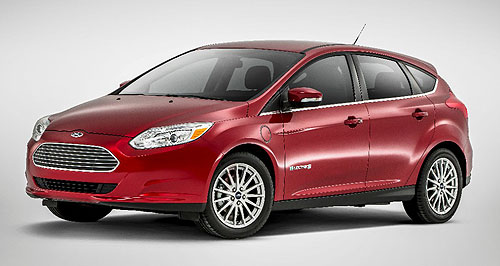News - FordFord holds off on hybrids, EVsNot likely: Ford’s new-gen Mondeo is due in Australia early next year, but don’t expect the hybrid version to be offered here. Electrified Fords on hold as Australian market is not ready: Worthington28 Nov 2014 FORD is holding off an introduction of electric, hybrid or plug-in hybrid vehicles to its Australian line-up, as it believes the local market is not yet ready for it. Speaking with GoAuto at the FG X Falcon launch in northern Victoria, Ford Asia-Pacific product development vice-president Trevor Worthington said, while the car-maker has the “full suite of technologies” available to launch an electrified model, there is insufficient demand from Australian consumers. “To some extent if you are going to introduce it to a market, the market has got to be ready to sell it,” he said. “There are a number of markets, the US and Europe, where we have introduced those technologies. We are just not ready to do it yet. “There has to be a sort of significant customer pull to justify the level of unique engineering that is often required to get these cars from where they are right now, to the level of certification that would be required. “We do have the full range of technology and at the right time we will roll it out. What vehicle, I am not sure. But it’s not a question of the technology it’s a question of the business case really.” In the United States, Ford offers the Focus Electric full EV, and hybrid versions of the Fusion mid-sizer and the C-Max compact MPV. These models are also available in Europe, with the Fusion sold there as Mondeo. Ford Australia will source the new-generation Mondeo from its Valencia, Spain plant from next year, but it is unlikely that the hybrid-powered version will make it into local dealerships. As far as rivals go, Toyota’s locally built Camry Hybrid is the only challenger, but Kia has hinted at a hybrid version of its next-gen Optima due next year, and Honda has not yet ruled out a petrol-electric Accord for Australia. When asked if Australia would see electrified Fords this decade, Mr Worthington said regulations and laws surrounding fleet emissions in different markets also complicate the issue. “It all depends on what happens. If regulations and laws change… To some extent it’s about what is the next-best alternative and there are some markets that are making the cost of fuel economy, or the cost of fleet compliance so difficult that the only way to get there is by mandating that you are going to sell PHEVs or EVs and so that’s a kind of a different thing. “It’s a rapidly changing environment and to some extent our job in our planning and strategy groups is to understand what the regulations are doing for either manufacturers and what we believe they are going to do to us based on the technology that we have got.” Mr Worthington told GoAuto that autonomous vehicles with a Blue Oval badge are also some way off, as the company continues its research into driverless technology. “We are doing a lot of work with universities. We are doing a lot of fundamental research in software and infrastructure and driver controls. Through our research organisation, when we are ready to talk about it we will start banging our drum I guess.” Mr Worthington added that 2025 was a realistic timeframe for a full autonomous vehicle, but said many of the technologies are rolling out into Ford product now and in the near future. “What I have seen quoted is that we are not of the view that autonomous vehicles are going to be around until 2025 because it’s not just about the cars, it’s about the infrastructure that has to go with the cars. “Whether it be the computing protocols for how cars talk to information stations, how information stations talk to other cars or how that data is dissected and used. “Also it really depends on what the definition of autonomous vehicles is. There are lots of driver assist features that some people are calling autonomous. We have got a vast array of driver assist features – automatic park, lane keep, radar that controls what speed you are doing based on the speed of the car in front of you. “Some people roll all of those in a ball and call them autonomous features. We, right now would describe them as driver assist features because they make the drive easier, safer.”  Read more |
Click to shareFord articlesResearch Ford Motor industry news |
















Facebook Twitter Instagram